There are racing movies, and then there’s Le Mans. Imagine a film that’s less about the dialogue and more about the growl of engines, the squeal of tyres, and the white-knuckle tension of a 24-hour race where everything is on the line. Released in 1971 and starring the “King of Cool” himself, Steve McQueen, this film takes you to the heart of one of the world’s most iconic motorsport events: the 24 Hours of Le Mans. But don’t expect long-winded conversations or overblown emotional arcs – this movie puts you in the cockpit, where the roar of a Porsche 917 tells you more than any monologue could.
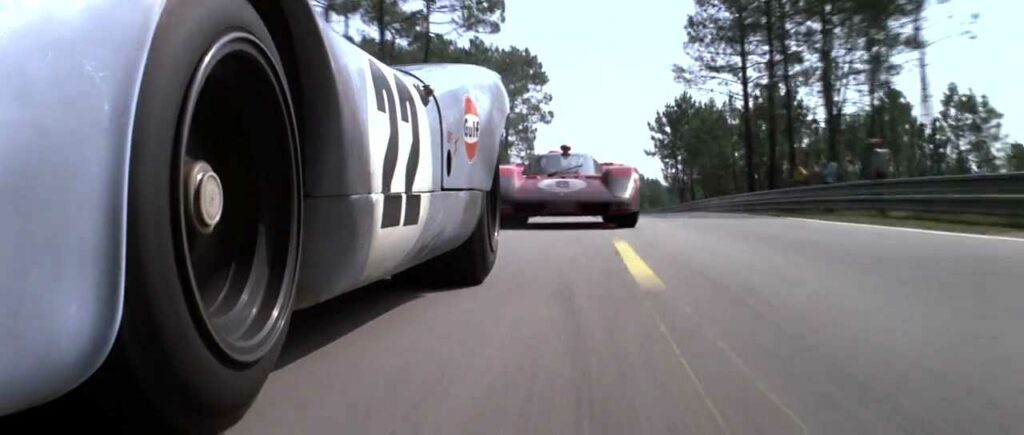
As professional car enthusiasts, we’ve seen plenty of films that try to capture the thrill of racing, but Le Mans is different. It doesn’t just show you the race – it makes you feel every corner, every gear shift, and every second ticking away as the drivers push their machines and themselves to the absolute limit. It’s as close as most of us will ever experience the legendary endurance race without strapping into a car ourselves.
Let’s be clear, though – Le Mans is a film that speaks to the soul of a true petrolhead. It’s gritty, raw, and almost entirely driven by action. And with Steve McQueen at the wheel, you know you’re in for one hell of a ride. But how does the film hold up under scrutiny today, over 50 years after its release? Let’s start by looking at what distinguishes Le Mans from other racing films: its jaw-dropping realism.
Cinematic Realism and Racing Accuracy
If there’s one thing Le Mans gets right, it’s realism. Calling it realistic almost feels like an understatement – it’s more like a documentary disguised as a movie. There’s no sugar-coating here, no cutting corners (literally or figuratively). The film was shot at 24 Hours of Le Mans in 1970, using actual race footage, real cars, and fundamental drivers. That’s right – when you see a Porsche 917 flying past at 200 miles per hour, that’s not some clever CGI trickery. That’s a real car doing what it was built to do. For anyone who’s ever revved a car engine and felt their pulse quicken, this authenticity hits you like a shot of pure adrenaline.
I’ll admit, watching Le Mans can feel like getting dropped into the middle of the action with zero warning. There’s no long-winded exposition or detailed backstory to ease you into things – it’s just you, the cars, and the race. Some might say that’s a flaw, but to me, it makes the film so brilliant. It trusts the audience to figure it out and focuses on the thing that matters: the racing.

And boy does the film deliver on that front. From the first lap, Le Mans puts you in the driver’s seat. You can experience the track as the drivers did, thanks to pioneering in-car camera work. Every sharp corner, every dangerous overtake, every bump in the road – it’s all there, captured with an intensity that still holds up today. You can almost feel the car’s vibrations and tension in the air as the drivers battle exhaustion, mechanical failure, and the looming threat of disaster.
But let’s not forget the biggest ace up the film’s sleeve – Steve McQueen. A man who was as much a racing fanatic as he was a movie star, McQueen insisted on doing things the right way. He wasn’t content to sit back and watch from the sidelines. No, McQueen got his hands dirty, driving real race cars in natural conditions, pushing the limits both on and off the screen. His passion for racing bleeds into every frame, giving the film a sense of authenticity that no amount of special effects could ever replicate.
In short, Le Mans doesn’t just depict racing – it lives it. The film’s accuracy and commitment to realism make it a unique experience, especially for those who live for the thrill of speed and precision. It’s a film that doesn’t just tell a story; it drops you into the heart of one of the most gruelling races in the world, leaving you with a sense of awe and a deeper appreciation for the art of endurance racing.
Steve McQueen’s Influence and Performance
Steve McQueen wasn’t just any Hollywood star – he was the King of Cool, and in Le Mans, he’s at the peak of his powers. But let’s be clear: this isn’t your typical, glamorous McQueen role. Here, he’s more than just an actor; he’s a man on a mission. McQueen’s love for motorsport radiates through every scene, and you can tell that this film wasn’t just another paycheque for him. This was his passion project, and his fingerprints are all over it.
Now, McQueen’s character, Michael Delaney, doesn’t say much. The film is sparse on dialogue, which might surprise us in an age where we’re used to characters narrating their inner thoughts at every turn. But in Le Mans, the lack of chatter works. Why? Because McQueen’s performance isn’t about words – it’s about presence. His calm, stoic demeanour mirrors the focus and intensity required of a professional racer. In Le Mans, actions speak louder than words, and McQueen’s ability to convey emotions through subtle looks and body language makes you feel like you’re watching a real driver preparing for the battle of his life.

The beauty of McQueen’s role here is that it’s a far cry from the typical Hollywood hero. Delaney isn’t some invincible character who always wins and gets the girl. He’s a guy who’s obsessed with racing and who carries the scars of past mistakes (both literal and metaphorical). There’s a quiet, haunted quality to him that adds layers to the character, even if he’s not spilling his guts to the camera every five minutes. One of the film’s rare moments of vulnerability comes when Delaney interacts with the widow of a fellow driver. Their exchanges are brief and understated, but it’s a stark reminder of the dangers these racers face every time they get behind the wheel.
And let’s not forget: McQueen wasn’t content to let a stunt double do all the work. He wanted to drive – and drive fast. This wasn’t just for show, either. McQueen had serious racing credentials, having competed in events like the 12 Hours of Sebring. His involvement in the actual racing scenes gives the film its authenticity. When you see McQueen behind the wheel, you know it’s not some Hollywood trickery. He’s there, pushing the limits, feeling the road under him, just like any other racer at Le Mans.
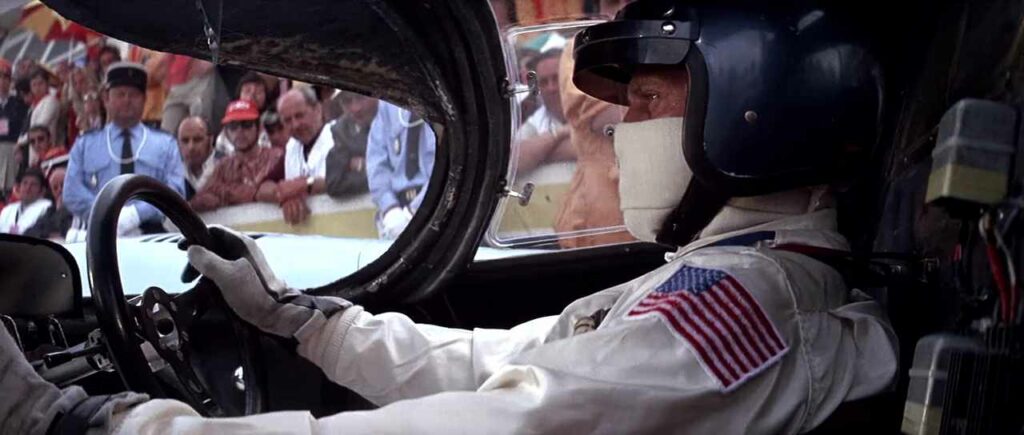
But McQueen’s influence goes beyond just his on-screen performance. As a producer, he was deeply involved in filmmaking, demanding that the film stay true to the sport he loved. He brought in professional drivers, insisted on using actual race footage, and pushed for the film to prioritise accuracy over drama. His obsession with authenticity was both a blessing and a curse during production – but without it, Le Mans wouldn’t have become the cult classic it is today.
In conclusion, McQueen’s performance in Le Mans perfectly reflects the man himself: cool, controlled, and deeply committed to his craft. He doesn’t need flashy dialogue or over-the-top heroics to make an impact. His quiet intensity on and off the screen makes Le Mans a compelling film. It’s clear that for McQueen, this wasn’t just acting – it was personal. And that’s what sets this film apart from any other racing movie.
Cinematography and Visual Style
If one aspect of Le Mans truly stands the test of time, it’s the cinematography. To say that this film looks fast is an understatement – it feels fast. Watching Le Mans is like strapping yourself into the driver’s seat and tearing down the Mulsanne Straight at over 200 mph, wind in your face, adrenaline pumping, and the world blurring past. The film’s groundbreaking visual style is one of its most outstanding achievements, making Le Mans a unique experience, even for today’s audiences used to CGI-fuelled spectacles.
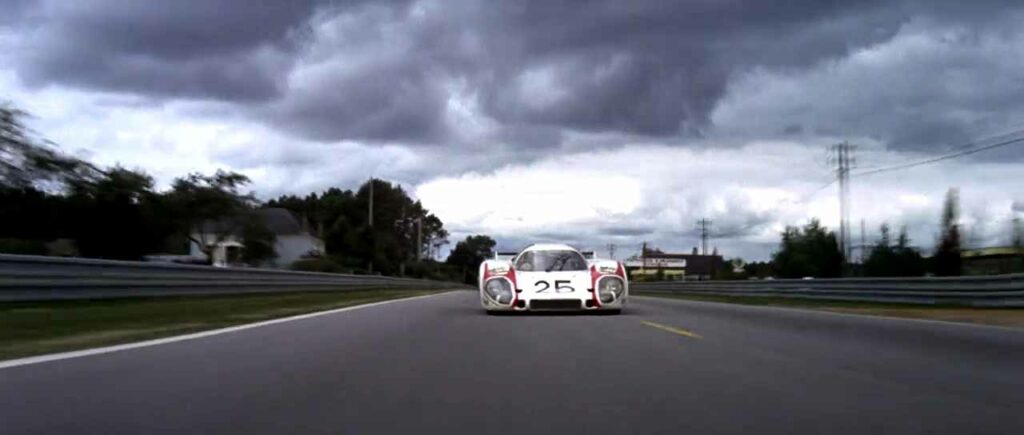
Director of Photography René Guissart Jr. and his team didn’t just film the race – they put you in the thick of it. They pioneered using in-car cameras to capture the speed, the danger, and the sheer physicality of endurance racing. This was a game-changer in motorsport cinema. These weren’t just static shots of cars zooming by but dynamic, visceral sequences that brought the audience into the cockpit. You could almost feel the car shuddering beneath you as it hit a corner, the steering wheel fighting in the driver’s hands, and the tarmac flying beneath the tyres. It’s the kind of immersive filmmaking that makes you grip your seat as if you’re the one driving.
The film heavily uses POV (point-of-view) shots, particularly during the racing sequences, giving you the sensation of being on the track. Whether weaving through traffic or careening down a straight at top speed, the cinematography puts you in the driver’s seat – it’s a first-person experience that feels as dangerous and thrilling as it looks. It’s easy to forget you’re watching a movie when you’re taken through the heart of the action with such precision.
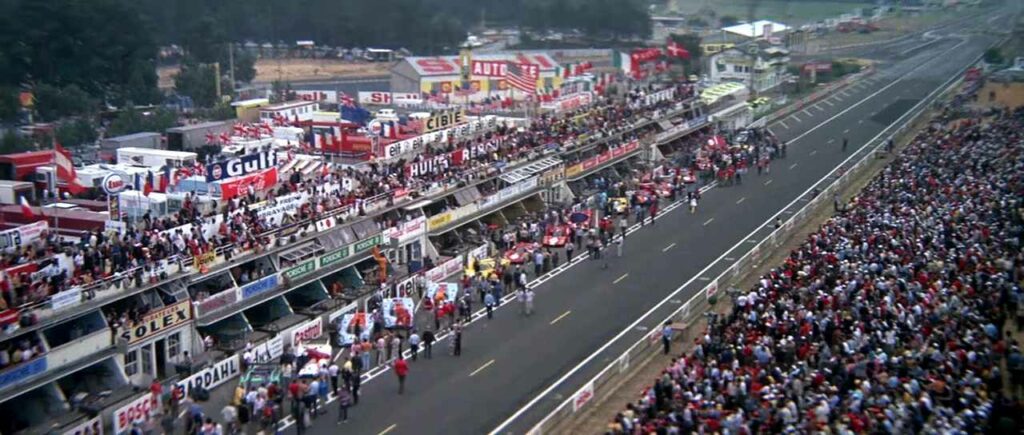
Wide shots of the iconic Le Mans circuit, with its long straights and sweeping curves, add to the film’s grandeur. You get a real sense of the race’s scale, how far these cars have to go, and just how gruelling 24 hours can be. These shots, often accompanied by the deafening roar of engines, create a sense of awe – the feeling you get standing trackside at an actual race. The expansive French countryside, juxtaposed with the manic energy of high-speed racing, adds a serene backdrop to the chaos on the track.
Of course, none of this would have worked if the filmmakers had relied on special effects. But this is 1971 – long before the days of digital magic. What you see on screen is what happened: real cars, real drivers, actual speeds. The authenticity of the racing sequences gives the film its teeth. When a vehicle flips or skids off the track, it’s not a carefully choreographed CGI stunt – it’s an actual event captured on film. That level of authenticity is almost unheard of in modern filmmaking, and it’s one of the reasons Le Mans has earned such a dedicated following over the years.
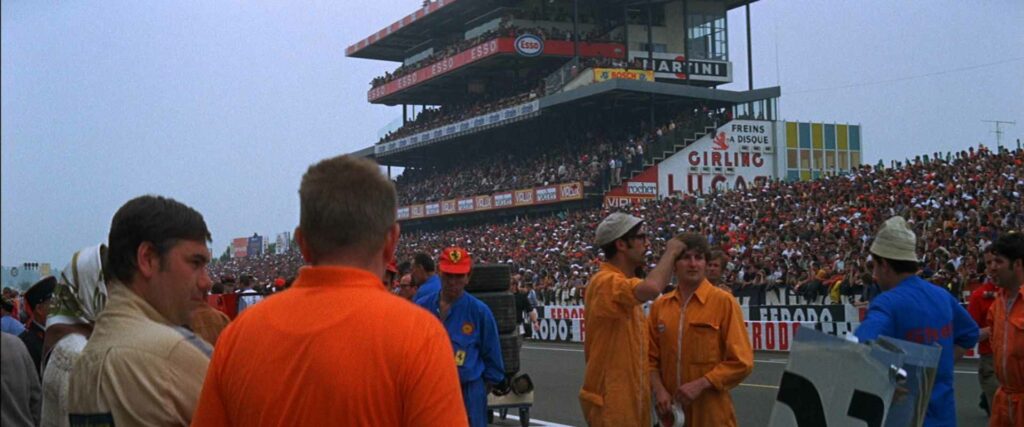
One of the most striking aspects of the film’s visual style is balancing action with moments of quiet reflection. For every high-speed chase down the straight, there’s a lingering shot of the pit crew waiting anxiously or a driver catching a moment of rest. These quieter moments are beautifully framed, highlighting the contrast between the relentless speed of the race and the tense calm of everything in between. It’s a reminder that endurance racing isn’t just about raw speed – strategy, patience, and surviving the long haul.
In conclusion, the cinematography in Le Mans is a triumph. It captures the essence of endurance racing like no other film has done before or since. The innovative in-car camera work, sweeping wide shots, and actual race footage make the film feel as exhilarating and authentic as the 24 Hours of Le Mans. It’s a visual masterpiece that still resonates with audiences today, proving that nothing beats the real thing when it comes to capturing speed on film.
Direction and Structure
When you think of racing films, the first thing that comes to mind is often the thrill, the action, the need for speed. But Le Mans, under the direction of Lee H. Katzin throws convention out the window. Rather than following a traditional, character-driven narrative, Katzin focuses on the pure, unrelenting reality of the race. It’s less about what’s said and more about what’s done – a bold move that defies Hollywood norms and makes the film stand out even today.
This film isn’t for everyone. You might be left scratching your head if you’re expecting a tightly scripted drama filled with character arcs and plot twists. Le Mans doesn’t waste time on unnecessary dialogue or backstory. The movie has so little dialogue that it almost feels like a silent film in some parts. And yet, that’s what makes it such an honest portrayal of endurance racing. Katzin knew that Le Mans wasn’t about chatter – it was about the grind, the physical and mental endurance required to survive 24 hours on one of the most challenging tracks in the world.

Katzin’s direction is all about immersion. From the very start, you’re thrown headfirst into the action, with the sounds of engines revving and the sight of cars hurtling down the track. The film’s opening moments set the tone: no big speeches, no flashbacks, just the race and the intense preparation that goes into it. It’s a film that speaks through its visuals, sound, and the unspoken tension between the racers, teams, and even the cars.
This minimalist structure might seem unconventional, but it’s a stroke of genius. By stripping away unnecessary narrative clutter, Katzin lets the race become the central character. The film follows the flow of the race, with all its ups and downs, moments of triumph and disaster. The tension builds naturally, without the need for overblown theatrics. It’s a testament to the idea that sometimes, less is more – especially when the subject is as raw and visceral as Le Mans.
One of the unique aspects of Le Mans is its pacing. It mirrors the endurance of the race itself. There are moments of heart-pounding intensity as the cars battle it out on the track, but these are balanced with quieter, slower moments in the pits or during the few moments of rest that the drivers get. This ebb and flow mirrors the rhythm of the 24-hour race, capturing the track’s chaos and the systematic, strategic thinking happening off it. Katzin uses these pace shifts to reflect the race’s mental and physical toll on the drivers and their teams.
Of course, this structure also comes with its challenges. The lack of traditional narrative means Le Mans can feel slow or disjointed to viewers used to more conventional storytelling. The film doesn’t spoon-feed you character development or motivations – instead, it asks you to observe, pick up on subtle cues, and appreciate the story as it unfolds through action rather than words. But this approach feels authentic for motorsport fans, capturing the essence of racing in a way that more polished Hollywood productions often miss.
Ultimately, Katzin’s direction and the film’s unconventional structure give Le Mans power. It’s not just a film about racing; it’s about racing. It respects the sport by staying true to its fast, unpredictable, and often brutal nature. The lack of a traditional storyline might throw off some viewers, but for those who live and breathe motorsport, it’s a refreshing, immersive take on the world of endurance racing.
Sound Design and Music
If there’s one thing that Le Mans nails, it’s the sound design. And let’s be honest – a racing movie without the roar of engines would be like a rock concert with no guitars. From the moment the film starts, the sound of high-powered engines revving up practically leaps off the screen and grabs you by the collar. In a movie that’s light on dialogue, the sound is everything, and Le Mans uses it to full effect, pulling you into the race as if you’re standing right in the pit lane, surrounded by the loud symphony of motorsport.
Forget traditional orchestral scores for a minute. This movie doesn’t rely on a swelling soundtrack to tell you how to feel. No, the music in Le Mans takes a back seat to the real stars: the engines. The sound design is so immersive that you can close your eyes and still feel the intensity of the race. From the throaty growl of a Ferrari to the high-pitched scream of a Porsche, each car has its voice, and those voices are perfectly captured in this film.
The filmmakers knew that for racing enthusiasts, the sound of the cars is just as important as how they look. Every gear change, every skid, every roar of the engine is crystal clear, adding a layer of realism that brings the race to life. You don’t just watch the cars battle it out on the track; you hear them, feel them, almost as if the vibrations are running through your seat. That auditory connection to the action keeps you engaged, even during the film’s quieter moments.
What’s particularly striking is how the sound is used to create tension. You’ll hear the engine note change as the car pushes through the gears, the tyres screeching as the driver goes too hard into a corner. There’s no need for dramatic music to signal danger – you can hear it in the engine’s strained whine, the chassis’ groan, and the sudden silence when something goes horribly wrong. In Le Mans, the soundtrack isn’t just background noise – it’s the film’s pulse.
But while the roar of engines takes centre stage, the film’s musical score, composed by Michel Legrand, is used sparingly and effectively. Instead of overpowering the action, the music comes in during those rare moments of quiet—the few breaths the drivers and teams can take when the cars aren’t hurtling down the track. These moments are rare, but when they arrive, the score provides a reflective contrast to the brutal noise of the race, capturing the emotional toll that racing takes on its drivers.
One of the most memorable uses of sound comes not from the action on the track but from the following silence. After hours of screaming engines and racing chaos, the moments of stillness – particularly when a car crashes or a driver’s race ends – hit hard. That sudden absence of sound after so much noise is almost eerie. It’s a reminder of the fine line between success and disaster in endurance racing, and it’s one of the ways the film subtly shows the human cost of the sport.
In conclusion, the sound design in Le Mans is nothing short of masterful. It turns what could have been a simple racing film into a full-on sensory experience, drawing you into the race with visuals and the raw, unfiltered power of sound. The engines are the stars here, stealing the show in a way that no traditional soundtrack ever could. If you’re a car enthusiast, the sound of Le Mans will stick with you long after the credits roll.
Themes and Emotional Impact
At first glance, Le Mans might seem like it’s all about the cars, the speed, and the spectacle of endurance racing. But look a little closer, and you’ll see that the film is exploring some surprisingly deep themes beneath the roar of the engines and the chaos of the race. It’s not just about who crosses the finish line first – about obsession, risk, and the personal toll that racing takes on those who live for the track.
One of the most potent themes in Le Mans is the fine line between life and death in motorsport. Racing isn’t just a sport – it’s a dangerous game where a single mistake can have devastating consequences. The film subtly explores the idea that for these drivers, the race is more than just competition – it’s a calling, an obsession. There’s a constant tension between the thrill of victory and the ever-present risk of catastrophe, and Le Mans doesn’t shy away from showing the consequences of pushing too hard. When things go wrong in this film, they go wrong fast and hard, with cars flipping, skidding, and sometimes burning, underscoring the physical and emotional dangers of the sport.
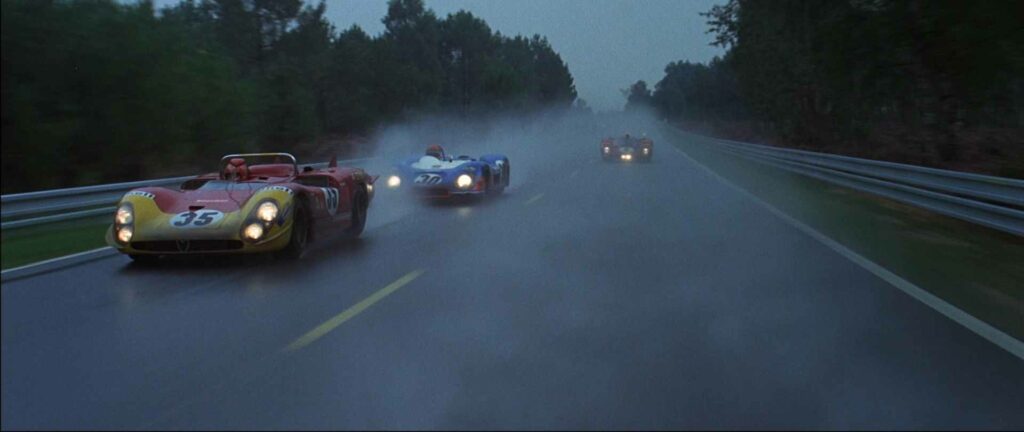
Steve McQueen’s character, Michael Delaney, perfectly embodies this theme. He’s not just racing for glory – he’s racing because it’s in his blood. The film hints at Delaney’s past trauma – an accident that claimed a fellow driver’s life – and you can see how that haunts him throughout the race. It’s not spelled out in dialogue, but it’s there in McQueen’s quiet, steely gaze and the moments of silence between the actions. He’s a man who has seen what the race can take from you, yet he’s still compelled to get behind the wheel. This theme of obsession, of being driven by something bigger than yourself, resonates throughout the film.
Then there’s the theme of isolation. Racing, particularly endurance racing, is often a solitary experience despite the team effort behind the scenes. Once the drivers are on the track, it’s just them and the car. Le Mans does a brilliant job of conveying the loneliness of the sport. The camera lingers on moments when the drivers are alone in their cars, their faces tense, their focus absolute. There’s no one else to rely on or share the burden. In these moments, you glimpse the mental toughness required to keep going, lap after gruelling.
The relationship between Delaney and Lisa Belgetti (played by Elga Andersen), the widow of a fellow driver killed in the race, adds another layer of emotional depth. Their interactions are minimal, almost painfully restrained, but they speak volumes about the emotional toll the race takes on those left behind. In these quiet moments, the film explores the human cost of racing – not just for the drivers but for the people who love them. Delaney’s guilt over the accident that claimed Lisa’s husband hovers over their every exchange, a constant reminder that in racing, the line between glory and tragedy is razor-thin.
Le Mans also touches on the theme of redemption. For Delaney, racing isn’t just about winning – it’s about confronting his past and proving something to himself. Every time he gets behind the wheel, there’s a sense that he’s facing down his own demons. It’s not just a race; it’s a personal journey, a fight to regain control of something that nearly destroyed him.
The film hits hardest emotionally when it shows the sacrifices made for the sport. The drivers risk everything – their lives, relationships, and futures– to compete at Le Mans. The film doesn’t glamorise this; instead, it shows the weight of these sacrifices, particularly in the quiet, reflective moments away from the track. In these pauses, you realise Le Mans isn’t just about the thrill of the race – it’s about the human stories behind it.
In conclusion, while Le Mans might be light on dialogue and traditional character development, it’s rich with themes that add depth to the action. The film explores obsession, isolation, risk, and redemption, all through the lens of endurance racing. It shows that the race is as much about the driver’s inner struggle as it is about the competition on the track, leaving a lasting emotional impact on viewers who look beyond the surface.
Reception and Legacy
When Le Mans was first released in 1971, it didn’t exactly light up the box office or earn glowing reviews from critics. The film’s unconventional structure – with its minimal dialogue and focus on racing over traditional storytelling – left many people scratching their heads. Critics of the time were looking for a movie that offered character development, dramatic arcs, and the sort of narrative flow that mainstream audiences expect. But Le Mans? It threw those conventions out the window and hit the throttle on what it wanted to be: a pure and straightforward racing film.
However, while the film didn’t wow critics, it did manage to connect with a specific audience – one that still holds the film in high regard today: car enthusiasts and motorsport fans. Over the years, Le Mans has gained a cult following, particularly among those who appreciate its authenticity and dedication to capturing the sport of racing in its truest form. It’s not a film for everyone, but Le Mans is nothing short of legendary for those who live and breathe motorsport.
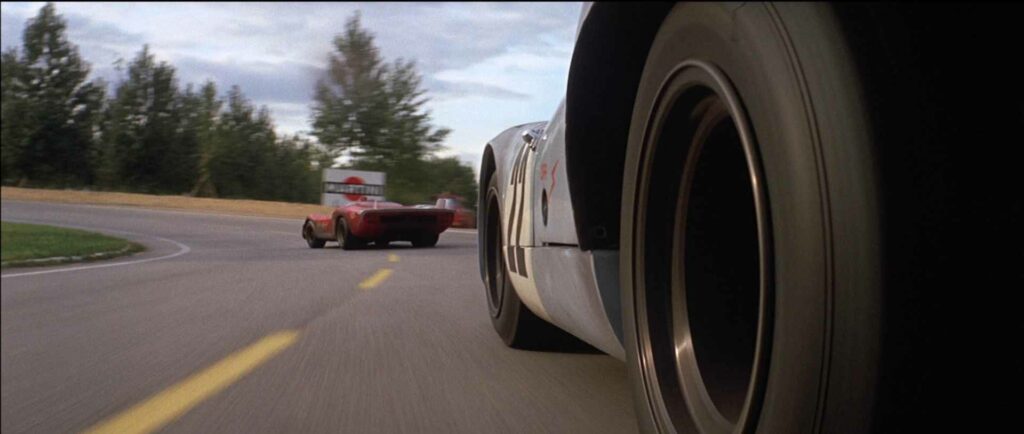
Its unparalleled commitment to realism makes the film’s legacy so enduring. Modern audiences, especially those accustomed to CGI-heavy blockbusters, might be surprised by how real Le Mans feels. That’s because it is accurate. The film was shot at the Le Mans circuit during the 1970 race, using footage from the event, real cars, and fundamental drivers. Even today, no other racing movie has captured the raw, unfiltered intensity of the sport quite like Le Mans.
And then there’s Steve McQueen. His passion for motorsport and personal involvement in the film have helped cement Le Mans as a cultural touchstone within the car community. For McQueen, this wasn’t just another role—it was a passion project. His performance and hands-on approach to the film’s production have only grown in appreciation over time. To this day, Le Mans is often hailed as one of McQueen’s most personal and authentic films, with his love for racing shines through in every frame.
As the years have passed, Le Mans has been reassessed by critics and filmmakers alike. It’s no longer viewed as just a niche racing film but as a unique piece of cinema that dared to do something different. In a world full of formulaic sports movies, Le Mans stands out as a bold attempt to push the boundaries of the genre, sacrificing traditional storytelling for something much rarer – an authentic portrayal of what it feels like to be in the driver’s seat during one of the most gruelling races in the world.
Its influence can be seen in later motorsport films, such as Rush and Ford vs Ferrari, both of which owe a debt to the groundwork laid by Le Mans. These modern films may offer more polished narratives, but they all carry echoes of Le Mans‘s dedication to realism and its unapologetic focus on the racing itself.
Today, Le Mans continues to inspire a new generation of motorsport enthusiasts. Whether through late-night screenings at car festivals, dedicated fan forums, or enthusiasts reliving the film at racing events, Le Mans has transcended its initial reception to become a cult classic. Its legacy endures not because of its box-office success or critical acclaim but because it captured the essence of racing like no other film has before or since.
In conclusion, Le Mans may have stumbled out of the gates upon its release, but its lasting impact within the motorsport community and beyond is undeniable. It remains a testament to Steve McQueen’s love for the sport and a cinematic experience like no other – one that prioritises realism and the thrill of the race above all else. For motorsport fans, Le Mans is more than just a movie; it’s a high-octane tribute to the spirit of endurance racing and the men who live for the checkered flag.
Conclusion
Le Mans isn’t your typical Hollywood racing movie. It’s not about flashy heroes, dramatic speeches, or triumphant endings. Instead, it’s a film that captures the raw, unvarnished reality of endurance racing like no other movie. With Steve McQueen at the helm, both on and off-screen, Le Mans puts you right in the heart of the action, letting the engines, the tyres, and the tension of the race tell the story.
The film’s commitment to realism, groundbreaking cinematography, and immersive sound design make it a cult classic among motorsport fans. Its unconventional structure and minimalist dialogue might not be for everyone, but for those who appreciate the sport, it’s a cinematic experience. Over 50 years later, Le Mans still stands as one of the most authentic and thrilling portrayals of racing ever put to film.
Whether you’re a die-hard petrolhead or just someone who appreciates a film that dares to be different, Le Mans is worth the ride. So, buckle up, turn up the volume, and prepare for one of the most immersive motorsport films you’ll ever experience.


